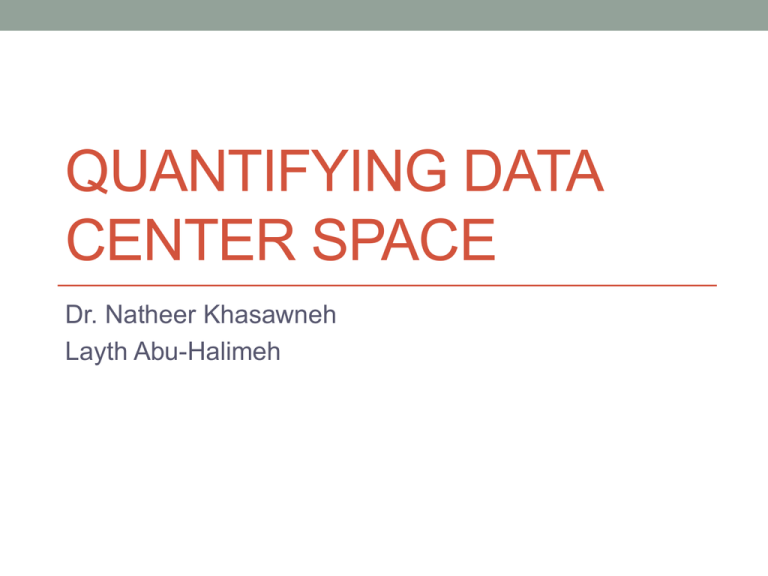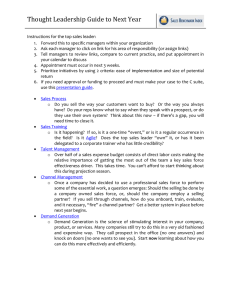QUANTIFYING DATA CENTER SPACE Dr. Natheer Khasawneh Layth Abu-Halimeh
advertisement

QUANTIFYING DATA CENTER SPACE Dr. Natheer Khasawneh Layth Abu-Halimeh This chapter will cover… • The physical footprint of Data Center • How to size it. • What a good configuration is. • Where to locate a server environment within a multipurpose building. • How to make it adaptable for the future needs of your business. • How to construct the Data Center to effectively protect the valuable equipment inside. • Outlines what additional dedicated areas are necessary to make Data Center functions effectively. Sizing the Data Center • Determining size is challenging because several variables contribute to how large or small your server environment must be, including: • How many people the Data Center supports. • The number and types of servers and other equipment the Data Center hosts. • The size that non-server areas should be depending upon how the room's infrastructure is deployed. • A smaller Data Center is less expensive to build, operate, and maintain than a larger one: • Cables are routed shorter distances. • Less fire suppression materials. • Costs less every month to power and regulate temperature. Sizing the Data Center--Financial factor • Quantity price breaks can apply to consumables and supplies that are used on a day-to-day basis in a functioning server environment, including: • Server cabinets, Patch cords, Custom signage, Multimedia boxes and patch panels into which structured cabling terminates, rolls of hazard tape for marking electrical infrastructure are frequently eligible for discount when bought in bulk. • With the costs of labor and material normally rising over time, a business is likely to spend less money overall to build a large Data Center all at once, rather than building a small room to start and then expanding it to the larger size within a couple of years. • Size of a Data Center has a psychological effect upon those who are toured through or work within the Data Center. Sizing the Data Center--Financial factor • keep in mind the advantages and disadvantages provided by both smaller and larger footprints. • Ideally, you want to create a server environment that is: • Large enough to accommodate your company's server needs for a reasonable length of time. • And achieve an economy of scale. • But not so large that money is wasted on higher operational expenses and portions of the Data Center that are unoccupied. Sizing the Data Center-Employee-Based Sizing Method • Determine the number of employees the Data Center is intended to • • • • • support and allocate a certain amount of floor space per person. This method is most appropriate for Data Centers that house engineering or development servers. Such machines are directly supported and worked upon by company employees. The more employees working to develop future products, the more servers that are typically necessary. When using the employee-based method, count only those employees whose roles are associated with Data Center servers and networking devices. The Data Center can support more employees per square foot because a minimum amount of floor space in any Data Center has to be devoted to non-server functions, regardless of whether the room is large or small. This non-server space includes areas for infrastructure equipment, such as air handlers and power distribution units and areas to transport equipment through, such as walkways. Once non-server areas are established in the Data Center's design, they do not grow proportionally as the rest of the room does. Sizing the Data Center-Employee-Based Sizing Method—continue… • Below table lists some approximate sizes for a Data Center, based upon the number of relevant employees working at the site. Employees Approximate Data Center Size Fewer than 100 10 square feet per employee 1 square meter per employee 200–250 5 square feet per employee 0.5 square meter per employee 400–500 4 square feet per employee 0.4 square meter per employee 1500–6000 2 square feet per employee 0.2 square meter per employee 15,000 1 square foot per employee 0.1 square meter per employee Sizing the Data-Equipment-Based Sizing Method • The more you know about what servers are coming in to the Data • • • • Center, both when it first opens and over time, the more accurately you can size the room. Most servers are configured to fit within one of a few standard cabinet profiles prevalent in the server industry. Some devices are intentionally designed to fit only in proprietary cabinets, forcing you to buy the manufacturer's cabinets along with its servers and these unique cabinets can be oversized or irregularly shaped. Still other servers require that they be installed on rails and then pulled out entirely from the cabinet to perform maintenance or to upgrade their internal components. The size and type of servers used in your Data Center affect not only the depth of the server rows, but also the space needed between those rows. Sizing the Data-Equipment-Based Sizing Method—continue… • The current trend in server design is to make them more compact (smaller in height but also deeper than older models, which can increase the depth needed for your Data Center's server rows). • When considering incoming equipment for purposes of sizing a Data Center, pay special attention to any devices that aren't specifically designed to go in to a server environment. • These miscellaneous items require greater floor space due to their irregular footprints, inability to fit into standard server cabinets, or access panels that require a large clearance area to open and perform maintenance. Other Influencing Factors When Sizing Your Data Center • Locating major infrastructure components within the Data Center or elsewhere (Power distribution units are located in the server environment, but it is possible to place them somewhere else). • Space required around server rows (Building codes often require a minimum of 36 or 42 inches (91.4 or 106.7 centimeters) for walkways. If you plan to give tours of the Data Center on a regular basis, consider making the main thoroughfares). • Structural reinforcements need to be accommodated? (If the Data Center is in a region at risk for hurricanes, earthquakes, or terrorist attacks, the room may require thicker walls and structural columns). • Assuming that Data Center has a raised floor, is the entrance ramp going to be located inside the Data Center or in a corridor leading up to it? (Alternatively, the room can be sunken so that the surface of the floor is level with the entrance, and no ramp is required at all) Determining Shape and Placement of Your Data Center • Square or rectangular shapes provide consistent boundaries in which to place large Data Center elements that are square or rectangular themselves. • Avoid shapes containing curved or angled walls, small alcoves, or dogleg spaces. • Shape and placement are obviously issues only if your Data Center is one of multiple spaces on a building floor. • If the Data Center occupies the entire story, its shape is automatically that of the building itself, and placement isn't a problem. Determining Shape and Placement of Your Data Center • Desirable and Undesirable Spaces to Place Your Data Center • Specifically, avoid areas adjacent to bathrooms or cafeteria kitchens. Not only are they potential sources of water leaks or fire. • But bathrooms or kitchens can be problematic to remove if the Data Center needs to be expanded in the future • You want your Data Center located so that it has a pre-determined area to expand in the future. • Growth Paths for Your Data Center's Space • Plan for later expansion of your Data Center during the initial design of the room. • Choose space for your Data Center's growth path that is easy to remodel and is not critical to the function of your business. • Employee cubicles, storage rooms, and conference rooms are all excellent for a Data Center growth path because they are relatively easy to relocate and replace. • Electrical rooms, lab spaces, and manufacturing facilities are problematic, on the other hand, because relocating them is difficult and disruptive of your company's daily operations. Determining Shape and Placement of Your Data Center • Consolidation Options for Your Data Center • Some circumstances can lead to the downsizing of your server environment. • Company may decide to shift its base of operations to another city or country. • With less manpower and fewer projects, there could be a reduction in the number of servers and therefore less Data Center space needed in the old location. • You want to design your Data Center so that it can scale down just as easily as up. Making the room modular and standardized. • Know exactly how to subdivide the Data Center in the future, if needed. Then strategically arrange and install infrastructure elements that provide coverage for the entire space. • If feasible, also leave extra floor space available around any server rows that would become adjacent to new walls in the consolidated Data Center. Extra floor space allows a proper aisle to be created, and lessens the chance of those server rows being disrupted by construction. Structure and Finishes of the Data Center • Avoid windows or transparent walls in your Data Center. • Windows or transparent walls make the room more • vulnerable to a break-in. • enable unauthorized personnel to potentially view sensitive data. • And, if they are located within an external building wall, increase the chance of incurring damage during a major storm or high winds. • If your Data Center must have windows facing the outside • Seal over them from the inside of the room to diminish the security risk the windows create. • Although the coverings are never to be opened for the Data Center windows, you want the exterior of the building to present a uniform image. • Don't advertise the presence of your Data Center through the absence of window coverings. • Also advisable is avoidance of external doors on your Data Center, that is no doors leading directly to the outside. • For Data Center windows that face the interior of the building, make sure that the inside of the server environment can only be viewed after someone has first passed through some sort of access control measures, such as a door with a badge reader system. Associated Data Center Support Rooms • Some of these rooms are simply convenience spaces that make tasks easier for Data Center users, while others are integral to the proper operation of a server environment. • Data Center only as productive and secure as its associated rooms. • These dedicated areas include the following: • Electrical room (The main electrical equipment that supports your Data Center). • Networking room/Data room (The centralized area where all structured data cabling for the site). • Loading dock (Here equipments can be easily received and transported to either a storage area • • • • • • or build room). Build room/fitup room (For system administrators and network engineers to unpack, set up, and pre-configure equipment that is ultimately bound for the Data Center) Storage room (Storing Data Center–related materials for longer periods of time). Operations command center/ control room (Workspace where employees remotely monitor Data Center servers) Backup room (workspace for support personnel who perform and monitor backups for the servers in the Data Center). Media storage area (for the storage of magnetic, optical, or whatever other media is employed to regularly back up). Vendor service areas (for vendors to do their significant amount of work in your Data Center). • Read more about the rooms in the text book.


